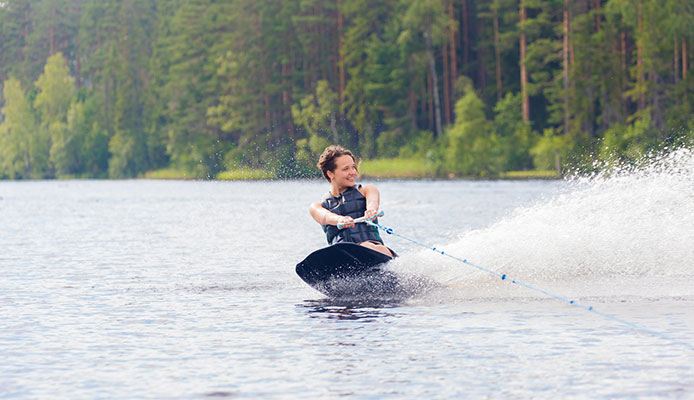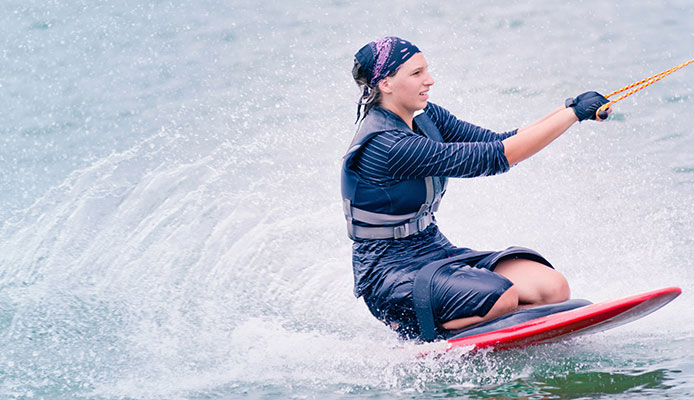
Compared to other board sports, kneeboarding and wakeboarding seem to have the most similarities. However, while the two sports have much in common, they do have many differences too.
The most evident dissimilarity between wakeboarding and kneeboarding in the form a rider assumes when riding his/her board. Kneeboarding involves kneeling on the board as you are being pulled by your towboat while wakeboarding has you standing on your board still be towed by a boat.
In this kneeboarding vs wakeboarding comparison guide, we will take a deeper look at both the similarities and differences relating to the two sports. If you have been trying to choose one sport out of the two, our wakeboarding vs kneeboarding guide will help you make a decision.
Kneeboarding vs Wakeboarding Similarities
1. Requirements
Two of the best water adventures, wakeboarding, and kneeboarding have very similar requirements. These include:
Water Body
You will need a large water body that can accommodate the boat that will move you around. Most people prefer a boat with a tower to get a higher tow point so that the rider can get enough air in his/her jumps.
Tow Line
To be towed by a boat, you will need a tow line with a good handle at the end. Both board sports use tow lines with very little to no stretch so the riders can do tricks and get air more easily.
Sports Wear
Both sports need similar clothing, with riders wearing board shorts and rash guards in the summer, and wetsuits in colder conditions. To protect their heads, both kneeboarders and wakeboarders wear a safety helmet while a good life jacket helps keep them from drowning.
Body Requirements
Both sports require upper body strength, with kneeboarder needing the ability to pull themselves up onto their board and hold on the towline while doing tricks. With wakeboarding, riders use shoulders and arms to hold onto the towline handle while getting up on the board and riding.
2. Average Boat Speed
When comparing wakeboarding vs kneeboarding in terms of speed, the two sports have similar speed range. On average, the boat reaches speeds of between 15 and 30 miles per hour, with the acceleration depending on the rider’s weight.
3. Board Materials
Kneeboarding vs wakeboarding boards are made of the same raw materials. The two boards are smooth underside to ensure that they can glide over water easily. Both sports offer several kinds of boards, with riders choosing the one that best suits their application of use.
You might also like: Perfect Wakesurf Shapers
Wakeboarding vs Kneeboarding Differences
The major kneeboarding vs wakeboarding differences include:
1. Equipment Design
While both wakeboarders and kneeboarders use boards, the boards are distinct for each sport in terms of design. The best wakeboards have lengths of between 47 and 58 inches while the best kneeboards feature a length of 60 to 78 inches. Wakeboards do not need to be as long since the rider will be standing instead of sitting.
Kneeboards are up to 4 inches thick, including the rubber pads for the rider’s knees. Wakeboards are much thinner, featuring a thickness of about 1.25 inches.
The bottom of the kneeboards can be curved or flat depending on how the rider intends to use the board. Wakeboard bottoms, on the other hand, can have featureless or concave bottoms.
While kneeboards may come with fins, these are not a requirement for the watersport. Without fins on the kneeboard, it is generally easier for the rider to perform surface spins. Wakeboards generally have fins to help with direction and to increase control in the water.
Both boards can have rounded edges, but the edge’s purpose varies. A wakeboard with rounded edges offers a smooth ride and is much better for performing tricks. The rounded edges on a kneeboard create smooth turns. Sharp edges on wakeboards offer speed and acceleration, while kneeboards with sharp edges allow harder cuts at the wake for higher jumps.
Riders generally stay on their boards in different ways in each of these board sports. Wakeboarders use bindings to attach their feet to the wakeboard, allowing them to ride while standing up. In kneeboarding, riders use a Velcro strap secured over their legs to keep them in place.
You might also like: Kneeboarding VS Wakeboarding: Comparison Guide
2. Stance on the Board
When wakeboarding, riders stand on the board with their knees slightly bent and one foot in front of the other. Before getting on the board, a rider has to determine which foot feels more comfortable when placed in front. When kneeboarding, all kneeboarders ride the same way – that is, in a kneeling position, sitting on their heels with a strap passing over their thighs to secure them on the kneeboard.
The way riders get on their board is different. When wakeboarding, the wakeboarder has to keep his/her knees bent to their chest and arms stretched in front, holding the towline handle. Once a rider gets up on the board, he/she can slightly lean back to maintain balance.
When kneeboarding, riders start with their stomach in deep water, their arms placed under the strap, and holding onto the towline handle. The rider is supposed to be forward enough on the kneeboard to easily tuck their knees under once their boat starts moving. After pulling the knees up until they are flat against the kneeboard, the rider tightens the strap over their legs, keeping their weight towards the board’s back by leaning back slightly.
3. Ability to Do Tricks
When comparing wakeboarding vs kneeboarding in terms of tricks, wakeboarding wins. While it is still possible to do tricks when kneeboarding, wakeboarders are in a much better position to perform complicated stunts and tricks.
FAQs

Globo Surf Overview
With kneeboarding and wakeboarding having a wide range of similarities, most people can transition between the 2 sports without an issue. However, for rookies looking to select one sport to pursue or start with, understanding how kneeboarding vs wakeboarding compare and contrast is crucial. With our guide offering both similarities and differences, choosing an ideal board sport should be much easier.

